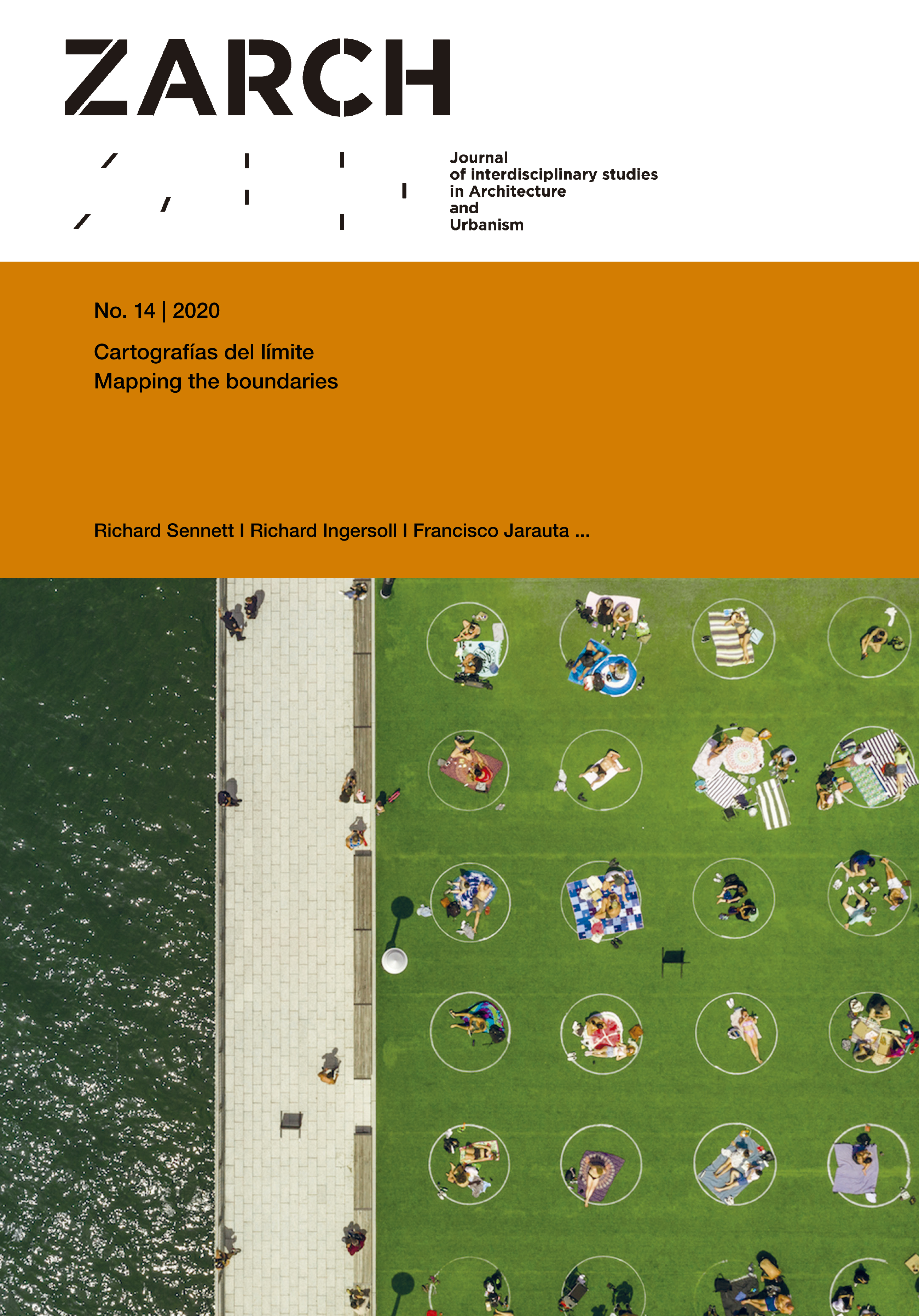Límites en gradiente y paisajes intermedios en la metrópoli dual de Medellín
DOI:
https://doi.org/10.26754/ojs_zarch/zarch.2020144303Palabras clave:
Metropolización, Expansión, Contraste, Periferia, PaisajeResumen
El borde urbano en la ciudad de Medellín –centro metropolitano del valle de Aburrá– responde a las características de ocupación, desarrollo y expansión de muchas de las ciudades latinoamericanas en las que se han venido generando procesos suburbanos y periurbanos cada vez más extensos y difusos que, para el caso en estudio, se presentan además como espacios de interfaz con áreas metropolitanas adyacentes. La línea imaginaria que separaba el borde urbano rural y el límite municipal y metropolitano solo existe institucionalmente. Su expresión urbana y paisajística responde mejor a lo que se enuncia y explica en este artículo con el concepto de ‘límites en gradiente’, entendido como la expresión contrastante e inequitativa de la ciudad dual, no solamente por su relación y distancia con el centro, sino por ser contenedores de procesos espaciales que se instalan de manera diferenciada y segregada desde el norte y hacia el sur de la ciudad y que pueden visibilizarse mediante cartografías y otras representaciones de esta transición espacial. Entre estos límites y los proyectos de contención de la urbanización se generan espacios intermedios que surgen como resultado de las tensiones entre estos procesos de metropolización con áreas de interfaz cuyos paisajes se encuentran en transición; algunos de ellos registran riesgo o signos de deterioro y otros están en proceso de consolidación. Todo ello, en conjunto con las áreas del límite, ilustra algunas de las contradicciones e hibridaciones de esta metrópoli dual de Medellín.
Mostras las descargas
Referencias
Abramo, Pedro. 2012. La ciudad com-fusa: mercado y producción de la estructura urbana en las grandes metrópolis latinoamericanas. EURE 38: 35-69.
Arias, Pablo. 2014. Periferias y nueva ciudad. El problema del paisaje en los procesos de dispersión urbana. Sevilla: Departamento de Urbanística y Ordenación del Territorio.
Colombia. Congreso de la República. 1997. Ley 388 de 1997. Por la cual se modifica la Ley 9 de 1989, y la Ley 2 de 1991 y se dictan otras disposiciones. Bogotá: Congreso de la República
Corporación Parque Arví. ¿Qué es la corporación parque Arví?. https://parquearvi.org/corporacion/corporacion-parque-arvi/ (consultado el 2 de diciembre de 2019).
Echeverry-Tamayo, Juan David. 2019. Medellín: una ciudad de encrucijadas. Pobreza, modelo de ciudad y cambio social en el proyecto Cinturón Verde. Territorios 40: 273-289. http://dx.doi.org/10.12804/revistas.urosario.edu.co/territorios/a.5535
ESA. Land Cover CCI Product User Guide Version 2. Tech. Rep. (2017). Disponible en: maps.elie.ucl.ac.be/CCI/viewer/download/ESACCI-LC-Ph2-PUGv2_2.0.pdf
Gómez Zotano, José, y Riesco Chueca, Pascual. 2010. Marco conceptual y metodológico para los paisajes españoles. Aplicación a tres escalas espaciales. Sevilla: Consejería de Obras Públicas y Vivienda. Centro de Estudios Paisaje y Territorio. http://www.upv.es/contenidos/CAMUNISO/info/U0643729.pdf
Hazar, Dalya, Kubat, Ayşe Sema. 2015. Fringe belts in the process of urban planning and design: Comparative analyses of Istanbul and Barcelona. A|Z ITU Journal of the Faculty of Architecture: 53-65. http://www.azitujournal.com/jvi.aspx?pdir=itujfa&plng=eng&un=ITUJFA-35220
Kapstein López, Paula y Gálvez Huerta, Miguel A. 2017. Identificación de una franja de periferias interiores de escala metropolitana en el sur de Madrid. Zarch: Journal of Interdisciplinary Studies in Architecture and Urbanism, 8: 118-131. https://doi.org/10.26754/ojs_zarch/zarch.201782150
Maira M., Javiera. 2014. Multidimensiones del límite y su renovación como concepto latente en la ciudad-contemporánea para un urbanismo crítico. Revista de Arquitectura vol. 18 núm. 25: 4-9. https://doi:10.5354/0719-5427.2014.32506
Medellín. Alcaldía. Acuerdo 46 de 2006. Por el cual se revisa y ajusta el Plan de Ordenamiento Territorial para el Municipio de Medellín y se dictan otras disposiciones. Medellín: Alcaldía de Medellín
_____. 2019. Metrópoli 2050. La superciudad de Medellín. Medellín: Área Metropolitana del Valle de Aburrá.
_____. 2019. Medellín Open Data. Medellín: Alcaldía. Subsecretaría de Tecnología y Gestión de la Información. Disponible en: https://geomedellin-m-medellin.opendata.arcgis.com/ (consultado en diciembre de 2019).
Medellín cómo vamos, “La desigualdad en Medellín sigue siendo muy alta”, https://www.medellincomovamos.org/la-desigualdad-en-medellin-sigue-siendo-muy-alta/ (consultado el 3 de diciembre de 2019).
Monclús, Javier y Carmen Díez Medina, Carmen. 2017. Vacíos urbanos y paisajes intermedios. En Visiones urbanas. De la cultura del plan al urbanismo paisajístico, eds. Carmen Díez Medina y Javier Monclús, 208-215. Madrid: Abada.
Naranjo Giraldo, Gloria. 1992 .Medellín en zonas. Monografías. Medellín: Corporación Región.
Neu, Tomás. 2016. El Paisaje Intermedio: Entre Lo Urbano Y Lo Rural. Una Franja De Transición. OPERA 19 (noviembre), 55-81. https://doi.org/10.18601/16578651.n19.05.
Nogué, Joan. 2008. Paisajes de frontera. Los límites de la ciudad. Métode 58: 70-77. https://metode.es/revistas-metode/monograficos/paisajes-de-frontera-limites-de-la-ciudad.html.
Pietro de la Viesca, Carolina. 2017. Atlas de paisaje en el litoral: Articulación de los espacios a antes mediante proyectos de paisaje. Tesis doctoral. Departamento de Urbanística y Ordenación del Territorio. Escuela Técnica Superior de Arquitectura de Sevilla. https://idus.us.es/xmlui/handle/11441/70817
Rosero, Laureano. 2017. Vacíos urbanos piezas estructuradoras de ciudad. Trabajo final de maestría. Facultad de Artes, Escuela de Arquitectura y Urbanismo, Universidad Nacional de Colombia, Bogotá. http://bdigital.unal.edu.co/56677/7/LaureanoRoseroM.2017.pdf
Rowe, Peter G. 1991. Making a Middle Landscape. Cambridge, Mass.: MIT press.
Sieverts, Thomas. 2016. Paisajes intermedios. Una interpretación del Zwischenstadt. Granada: Ediciones del Serbal.
Whitehand, Jeremy W. R. 2007. Conzenian urban morphology and urban landscapes. Proceedings, 6th International Space Syntax Symposium. Estambul. http://www.spacesyntaxistanbul.itu.edu.tr/papers/invitedpapers/Jeremy_whitehand.pdf





